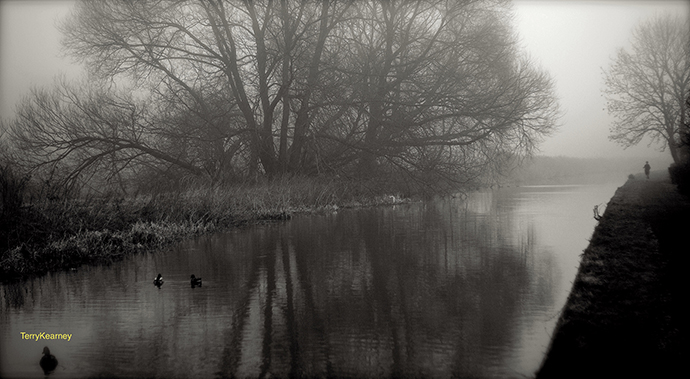Great Wyrley is a small rural parish in Staffordshire. A little more than a century ago it consisted of a few finely-built residences and farmhouses that sat on a bed of soil that was compounded of light loam and clay. The parish’s chief crops were wheat, barley, turnips and mangolds. It was connected to wider society by several fine roads which conducted traffic, alternately, to nearby Cannock, Walsall and Brownhills. It was also served by the local branch of the London and North West Railway.
Such was the scene in the mid-1890s when curious incidents began to trouble the local parson at his vicarage. An empty milk churn containing a dead blackbird was found on the garden lawn. A pewter ladle appeared on the window sill. A dead rabbit was pinned to the grass with a garden fork. Three eggs were broken on the front doorstep. Vile threatening notes began to drop through the letterbox – written on cheap lined paper, and posted from surrounding towns: Cannock, Walsall, Rugeley and Wolverhampton. Their contents were disquieting, vulgar, a scandal.
These were the beginning of The Great Wyrley Outrages that inform Julian Barnes’ novel, Arthur and George. The story flips between the perspectives of two men. George Edalji, the vicar’s eldest son, – shy, uptight and principled, and Sir Arthur Conan Doyle – a literary Goliath, propelled by a Victorian energy and adorned with an Edwardian moustache. Such types are not made to mix, and it appears that they would have never rested eyes on each other had a pit pony not been brutally attacked one rainy night in August 1903, just outside the colliery.
Barnes uses the case as a prism through which he casts his imagination. Throughout he writes with a careful, descriptive precision, evoking the landscape (‘It was a cold, clear February night, with half a moon and a heavenful of stars. In the distance the head gear of the Wyrley Colliery stood out faintly against the sky’) and delving into the character’s minds. His Conan Doyle is the righteous author, the romantic lover, the inquisitive civilian but also a man troubled by insecurities and depression: ‘When the fit is upon me, I doubt everything. I doubt I ever loved Touie. I doubt I loved my children. I doubt my literary capability. I doubt Jean loves me’, he rages to his mother in a fit of despair.
The plot is rooted in the late Victorian and Edwardian years – a time when attitudes and morals had softened somewhat. Members of Conan Doyle’s set wore tweed, went motoring, smoked briar pipes (but never in front of women), played tennis, cricket and golf and strolled the lanes, knowing each of the flowers by name. George Edalji, half Scottish half Parsee, oblivious to the racial prejudices which dogged him, studied hard and worked towards his ambition of a lawyer’s office in Birmingham and a bowler hat. Along the way he too made a contribution to Edwardian literature, if not a more peculiar and modest one, Railway Law for the ‘Man in the train’.
That the story is a true one renders it powerful. The same inquisitive tug that would have summoned Holmes from Baker Street brings Conan Doyle to Wyrley, outraged and indignant, ready to solve the case once and for all. He’s a good foil for the meek Edalji: a dominant gentleman of the highest rank who, at times, resembles a moralistic Rottweiler – snarling and raging at the incompetence he finds.
Arthur and George is a brilliant study of personality set against a frightful case. It’s also a story about belonging, not just for George whose Englishness is questioned throughout, but also for Conan Doyle who Barnes drily observes is ‘Irish by ancestry, Scottish by birth, instructed in the faith of Rome by Dutch Jesuits. Arthur becomes English.’ When they first meet Barnes unites the characters: ‘You and I, George, you and I, we are … unofficial Englishmen.’
Perhaps this is the theme which lies, even more that the outrages, at the heart of the book. They are both outsiders, Arthur and George. One of them victim of the gruff, hard-bitten Staffordshire society of his youth, while the other strives to expose it then set it right.
It seems somewhat apt for Barnes to fictionalise the story. When Edalji wrote to Sir Arthur asking for support in 1906 he was really appealing to the nimble mind that had created Sherlock Holmes. It was a case so odd, he felt, it required the author’s imagination to untangle it. After all, a novelist spends as much time theorising and forming narratives as a detective inspector must do. A policeman might deal with facts and a novelist might deal with fictions, but for George Edalji in 1906 the line which lay between the two had become so blurred that it didn’t much matter if he was served by one or the other.
Some cases require the novelist. Indeed it seems beyond argument that a careful novelist can serve the public far better than an incompetent police force. This is what Julian Barnes achieves here in a wonderfully enlightening combination of vivid imaginings and assiduously researched facts. He notes that with the exception of one invented letter, all others ‘whether signed or anonymous, are authentic; as are quotations from newspapers, governmental reports, proceedings in Parliament, and the writings of Sir Arthur Conan Doyle.’
—
Arthur and George by Julian Barnes. Vintage Books RRP £17.99
Image Credit: Terry Kearney
